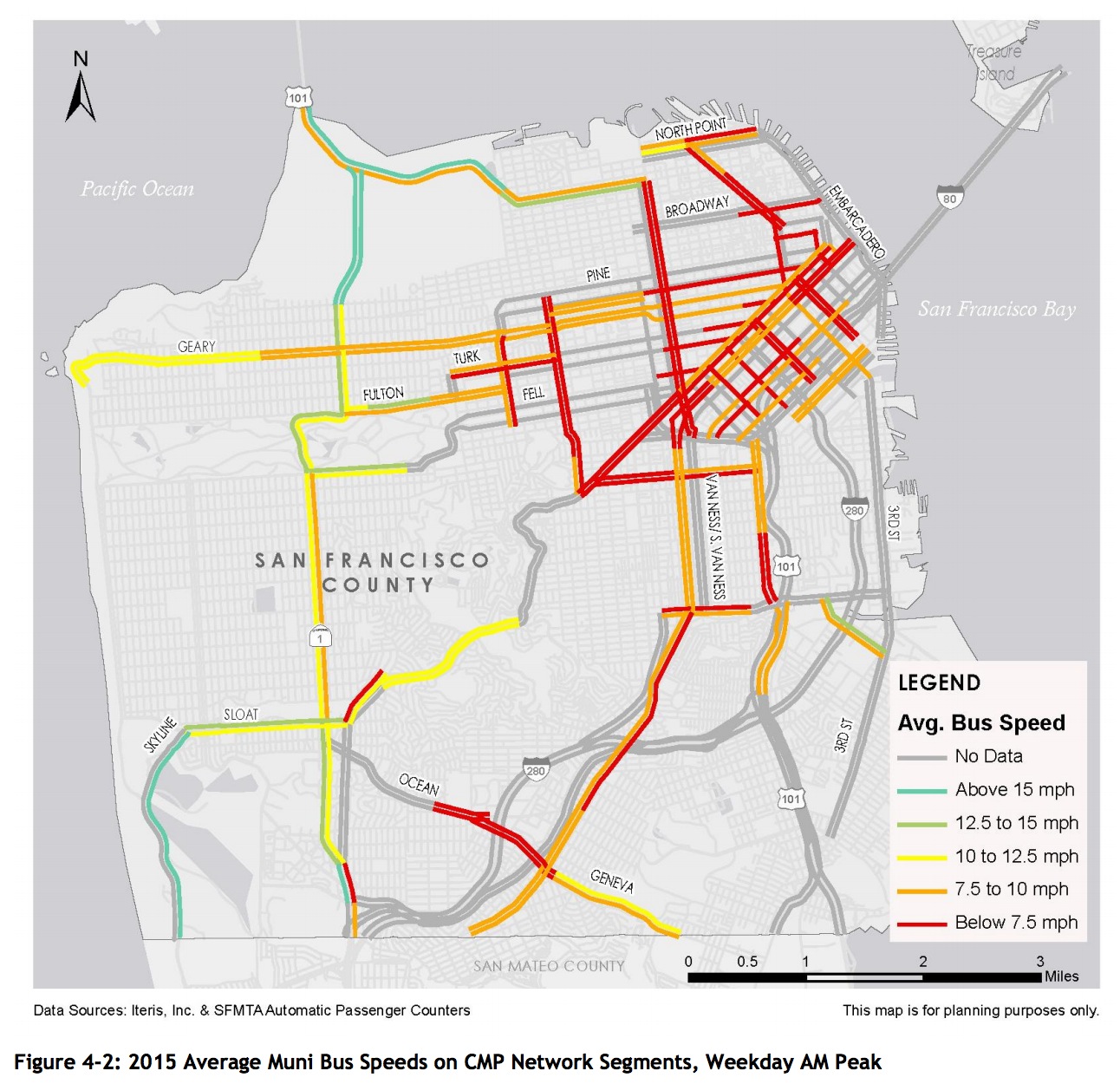SAN FRANCISCO COUNTY TRANSPORTATION AUTHORITY
Chapter One: Background and Program Overview
Key Topics:
- CMP Background
- Congestion Management in San Francisco
- 2015 Program Overview and Key Changes from 2013 CMP
1.1.1 | Purpose of the CMP
The purpose of the 2015 San Francisco Congestion Management Program (CMP), prepared by the San Francisco County Transportation Authority, (the Transportation Authority) is to:
- Comply with state law by adopting a biennial CMP and submitting it to the Metropolitan Transportation Commission (MTC) for a conformance finding.
- Guide San Francisco agencies involved in congestion management;
- Outline the congestion management work program for fiscal years 2015/16 and 2016/17; and
- Set forth policies and technical tools to implement the CMP work program.
1.1.2 | Organization and Approach
The document follows MTC’s Guidance for Consistency of Congestion Management Programs with the Regional Transportation Plan, per MTC Resolution 3000, last revised July, 2013.
Each element required by the CMP legislation is discussed in a separate chapter. Each chapter describes the element’s context in San Francisco, the work plan, and implementation guidance. The Transportation Authority Board will adopt any revisions developed during fiscal years 2015/16 and 2016/17 as amendments to the 2015 San Francisco CMP.
The 2015 CMP updates information from the 2103 CMP and reflects several important developments since 2013. The Transportation Authority prepared most of the 2015 CMP. The data in Chapter 4 (Multimodal Performance) is derived from a report prepared by Iteris, Inc. on behalf of the Transportation Authority. In preparing the CMP update, the Transportation Authority has consulted with the San Francisco Municipal Transportation Agency (SFMTA) and other partner agencies to update policies and compile system performance data.
1.1.3 | Origins and Intent of the CMP Legislation
CMP requirements were established in 1989 as part of a bi-partisan state legislative package, known as the Katz-Kopp-Baker-Campbell Transportation Blueprint for the Twenty-First Century (AB 471).
These requirements became effective when voters approved Proposition 111 on June 5, 1990. AB 1963 (Katz) in September 1994 and AB 2419 (Bowler) in July 1996 further modified CMP law. The passage of AB 298 (Rainey), effective January 1, 1997, made the CMP exempt from the California Environmental Quality Act (CEQA). SB 1636 (Figueroa), passed in September 2002, amended CMP requirements to allow local jurisdictions to designate Infill Opportunity Zones (IOZs). For the complete text of the CMP legislation, see Appendix 2.
The 1989 state legislation not only provided for increases in transportation funding, but also made significant changes in the requirements for planning and programming the transportation projects funded from these revenue sources. The goal of the legislation is to prioritize transportation funding decisions based on transportation system performance, local land use decisions and their impacts on transportation, and transportation control measures that address air quality goals.
The CMP requirements are the legislature’s response to the traffic congestion experienced by all urbanized areas of California. Traffic congestion is widely perceived as outpacing the ability of the traditional transportation planning process to provide solutions. In San Francisco, with its highintensity land uses and extensive transit network, traffic congestion poses a different problem than in lower-density counties, challenging conventional interpretations of the nature of the congestion problem. For the majority of the state’s highly suburbanized metropolitan areas, traffic congestion has its roots in the following:
Transit does not work well in the suburbs. The low-density suburban growth pattern throughout the state’s metropolitan areas does not lend itself to cost-effective transit service, and therefore mobility depends largely on automobiles and freeways.
Freeways full of solo drivers are inefficient investments. Pricing strategies (e.g., tolls, paid parking at work sites) are politically complicated, and ridesharing strategies (i.e., carpooling and vanpooling) have shown narrow success in sprawled suburbs. Most automobiles still carry just one person, regardless of trip purpose or time of day. The result is inefficient roadway facilities: even when full of cars, they carry only a fraction of the number of people they could accommodate.
Building freeways and widening roads to address transportation demand is not cost-effective. Because land for transportation facilities is scarce, construction costs have escalated, and environmental constraints are significant, the real costs of capital investment in roads have risen dramatically. These high-cost facilities, which maximize automobile trips but do not maximize the number of people carried, result in a high cost per person transported.
The CMP legislation aims to increase the productivity of existing transportation infrastructure and encourage more efficient use of scarce new dollars for transportation investments, in order to effectively manage congestion, improve air quality, and ultimately allow continued development. In order to achieve this, the CMP law is based on five mandates:
- Require more coordination between federal, state, regional, and local agencies involved in the planning, programming, and delivery of transportation projects and services;
- Favor transportation investments that provide measurable and quick congestion relief;
- Link local land use decisions with their effect on the transportation system;
- Favor multimodal transportation solutions that improve air quality; and
- Emphasize local responsibility by requiring a Congestion Management Agency (CMA) in each urban county in the state.
Download full version (PDF): 2015 Congestion Management Plan
About the San Francisco County Transportation Authority
www.sfcta.org
Guided by principles of accountability and transparency, the mission of the San Francisco County Transportation Authority is to provide financial strategy, planning expertise and project delivery and oversight, to help create a better city through improved mobility.
Tags: CA, Congestion, San Francisco, San Francisco County Transportation Authority







 RSS Feed
RSS Feed